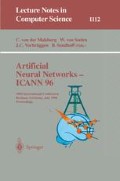Abstract
The associative net is a neural network model of associative memory that is unusual in having binary-valued connections between units. This net can work with high information efficiency, but only if the patterns to be stored are extremely sparse. In this paper we report how the efficiency of the net can be improved for more dense coding rates by using a partially-connected net. The information efficiency can be maintained at a high level over a 2–3 order of magnitude variation in the degree of pattern sparseness.
Preview
Unable to display preview. Download preview PDF.
References
Amaral, D., Ishizuka, N., & Claiborne, B. (1990). Neurons, numbers and the hippocampal network. In Storm-Mathisen, J., Zimmer, J., & Ottersen, O. (Eds.), Progress in Brain Research, Vol.83, pp. 1–11. Elsevier Science Publishers B.V.
Buckingham, J., & Willshaw, D. (1992). Performance characteristics of the associative net. Network, 3, 407–414.
Buckingham, J., & Willshaw, D. (1993). On setting unit thresholds in an incompletely connected associative net. Network, 4, 441–459.
Gardner, E. (1987). Maximum storage capacity in neural networks. Europhysics Letters, 4, 481.
Graham, B., & Willshaw, D. (1995). Improving recall from an associative memory. Biol. Cybern., 72, 337–346.
Graham, B., & Willshaw, D. (1994). Capacity and information efficiency of a brain-like associative net. In Tesauro, G., Touretzky, D., & Leen, T. (Eds.), Neural Information Processing Systems 7, pp. 513–520. MIT Press.
Nadal, J.-P., & Toulouse, G. (1990). Information storage in sparsely coded memory nets. Network, 1, 61–74.
Willshaw, D. (1971). Models of distributed associative memory. Ph.D. thesis, University of Edinburgh.
Willshaw, D., Buneman, O., & Longuet-Higgins, H. (1969). Non-holographic associative memory. Nature, 222, 960–962.
Author information
Authors and Affiliations
Editor information
Rights and permissions
Copyright information
© 1996 Springer-Verlag Berlin Heidelberg
About this paper
Cite this paper
Graham, B., Willshaw, D. (1996). Information efficiency of the associative net at arbitrary coding rates. In: von der Malsburg, C., von Seelen, W., Vorbrüggen, J.C., Sendhoff, B. (eds) Artificial Neural Networks — ICANN 96. ICANN 1996. Lecture Notes in Computer Science, vol 1112. Springer, Berlin, Heidelberg. https://doi.org/10.1007/3-540-61510-5_10
Download citation
DOI: https://doi.org/10.1007/3-540-61510-5_10
Published:
Publisher Name: Springer, Berlin, Heidelberg
Print ISBN: 978-3-540-61510-1
Online ISBN: 978-3-540-68684-2
eBook Packages: Springer Book Archive

